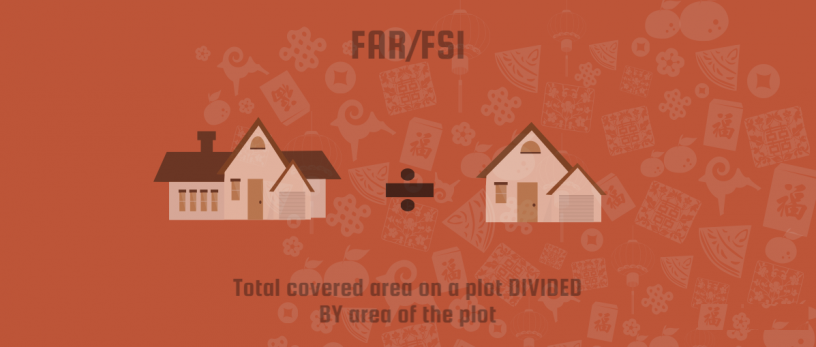What is FAR and FSI? How does floor area ratio impact property price?
Share What is FAR and FSI? How does floor area ratio impact property price?
Floor Area Ratio (FAR) is a term that is frequently used in Real Estate and is one of the key determinants for development in the country. A low FAR is considered in the case of India is a deterrent to construction. The real estate industry has always been longing for a hike in FAR. The rapid urbanization has already put pressure on the limited land resources, especially in Delhi. Extra FAR would help developers with extra space and in meeting the demand and supply gap.
What is Floor Area Ratio?
Floor area ratio (FAR) also known as floor area index (FSI) is a ratio of building’s total floor area to the size of the land upon which the building is built. And the floor area ration can be calculated by dividing the total or gross, floor area of the building by the gross area of the lot.
FAR calculation formula
FAR calculation = (the Total covered area on all floors, gross floor area) / (area of the plot)
Importance of Floor Area Ratio
Every city has a limited space that can be used safely. And usage of space beyond that safe point puts undue stress. This is sometimes known as the safe load factor and the FAR is that safe load factor. Floor area ratio varies because of population dynamics, growth patterns, and construction activities and because the nature of the land where a building is constructed varies. Industrial, residential, commercial, agricultural and non-agricultural spaces have different safe load factors, thus they typically have different FARs. In the end, governments put regulations and restrictions that determine FAR into effect.
What is Floor Space Index?
Floor space index (FSI) also known as Floor area ration (FAR) value varies from place to place, which can be obtained from the Zoning Regulation of the particular land or site.
Floor space index is used to calculate the Built Up area of the site and also to calculate the No. Of Floors that can be constructed.
The higher value of FSI or FAR indicates that the construction is more dense, whereas the lesser value of FSO or FAR means a sparse type of construction.
For example- If FAR or FSI value is 2.0, it means that total floor area is twice the gross area of the plot, and thus it means that this type of FSI or FAR value suggests a multi storey building.
FSI Calculation formula
FSI calculation = (Total constructed area) / (total land area)
Difference between Floor Area Ratio (FAR) and Floor Space Index (FSI)
FAR and FSI are the unified development codes that are applicable in various cities. Both the terms are related to the field of real estate. This ratio of FAR and FSI is obtained by dividing the built up area of a building with the total size of the plot. Thus, both FSI and FAR are exactly same.
Thus, FSI or FAR = Built up area/ Total area of the plot
The concept of FAR and FSI was introduced in America. And it was introduced for the building control to help architects design a building according to the given ratios. Although, FAR and FSI are the same terms. However, Indians prefer to use the term FAR, whereas in other countries people use the term FSI more frequently.
Built Up Area (BUA)
Built up area is the area which is totally covered by internal and external walls and it also includes ducts & Interior part. It is also known as the total covered area of the apartment or commercial property unit and is the sum of carpet area; the area covered by the thickness of walls and includes the terrace, balcony, and other livable areas. Built up area is actually Gross floor area, but it includes parking and other services subjected to the building or the project as well.
What built up Area covers?
- External & Internal walls
- Carpet Area
- Utility Ducts & Interior part(sewage/water pipeline, Interior part of Door and window AC ducts and shafts etc)
How do we calculate Built up Area?
Carpet Area + Area of walls + Area of Utility & Interior part = Built Up Area
Generally, the built up area is 10 % more than the Carpet area.
Example – If Carpet area is 1000 sq.ft then the built up area would be around 1100 Sq Ft.
Gross Floor Area (GFA)
Gross floor area is the total floor area of a building and it includes any underground leasable area like basement shops but it excludes the parking area and underground technical areas. GFA includes the area of all floors except the areas exempted under certain regulations.
How do we calculate Gross Floor Area?
Gross Floor Area (GFA) + Net Floor Area (NFA) = Construction Floor Area (CFA)
How does floor area ratio or Floor Space Index impact property price?
Floor area ratio (FAR) or Floor space index (FSI) is the major factor that influences the price of a plot or land. FAR is helpful in knowing the parameters of a plot like the size and width, thus we get to know how much land we can utilize. But, the FAR depends on the different area and thus it varies accordingly.
When FAR increases the chances of getting a better utilization, housing stock and space goes up. And when the builder will construct more and sell more, then the reasonable charges will be charged from the home buyer. Thus, higher the Floor area ratio, the higher the price of the property.
So, this is FAR and FSI and this is how FAR impacts property price.
Disclaimer: Article published by Imperia Structures
Request a Call Back

